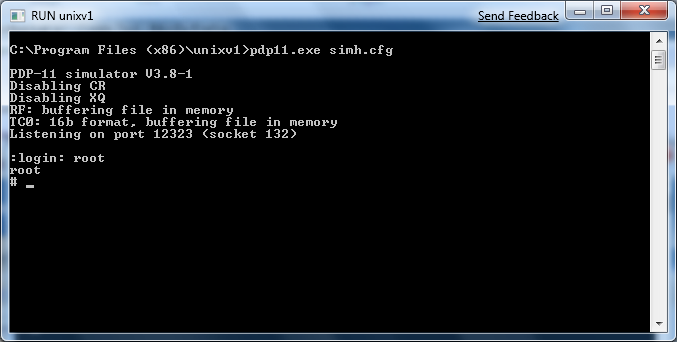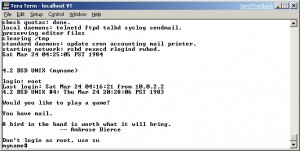Ok, good news, I got it to boot! The bad news is that it’s kind of complicated… First you need a working UNIX/32V machine. And what’s worse is that UNIX SYSIII is not ‘free/shareware’ or anything like that. You need a license to run it.
It cost $100 to get one.
But they don’t sell it anymore.
So this is for the few people with a SYSIII license.
Anyways, to get the jump on SYSIII you need to add a second disk to a working UNIX/32V install. So after a while I managed to work out getting a second HP disk online on 32v, formatting it, and restoring a bare SYSIII install… (Nao’s 32v tape image has support for more then one HP disk, it was just a matter of figuring out the
major/minor for the 2nd disk (0/8,0/14)).
From the extracted cpio’s I took the following files (after looking at
the source of cmd/init.c):
/etc/init
/etc/inittab
/bin/sh
/bin/ls
/bin/env
Then I just created the following device files:
crw-rw-rw- 1 console console 0, 0 Jun 23 09:24 console
crw-rw-rw- 1 console console 3, 0 Jun 26 1979 null
brw-rw-rw- 1 console console 0, 0 Jun 26 1979 rp0a
brw-rw-rw- 1 console console 0, 7 Jun 26 1979 rp0h
brw-rw-rw- 1 console console 0, 8 Jun 26 1979 rp1a
brw-rw-rw- 1 console console 0, 14 Jun 26 1979 rp1h
And fired it up!
——–
VAX780 simulator V3.8-1
$$ unixhpht
UNIX/3.0.1: unixhpht
real mem = 8323072
avail mem = 8207872
# ls
bin
dev
etc
unixhpht
# cd bin
# ls
env
ls
sh
# cd /
# ls
bin
dev
etc
unixhpht
# cd dev
# ls -l
/etc/passwd file cannot be opened for reading#
#
# ls>/etc/passwd
# ls -l
/etc/group file cannot be opened for reading#
#
# ls>/etc/group
# ls -l
total 0
crw-rw-rw- 1 console console 0, 0 Jun 23 09:24 console
crw-rw-rw- 1 console console 3, 0 Jun 26 1979 null
brw-rw-rw- 1 console console 0, 0 Jun 26 1979 rp0a
brw-rw-rw- 1 console console 0, 7 Jun 26 1979 rp0h
brw-rw-rw- 1 console console 0, 8 Jun 26 1979 rp1a
brw-rw-rw- 1 console console 0, 14 Jun 26 1979 rp1h
#
——–
So now the remaining thing to do is to add another HP disk, format it
under SYSIII, and restore onto it… I wish I could share more of my
work, but I figure this will help someone down the road who wants to
venture down the SYSIII on the 11/780.



